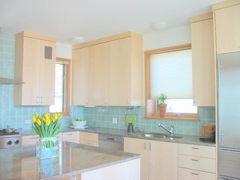
SUSTAINABLE MATERIALS
Environmental impact was a key consideration in the selection of materials to be used in the construction of the house. For each building component, the resource efficiency of the various options available was assessed, and efforts were made to select materials having one or more "green" characteristics.Although ecological concerns have heightened awareness of the need to protect the world's forests from overconsumption, wood continues to be a desirable building material. A renewable resource, it requires less energy than most materials to process into finished products and is low-toxic and biodegradable. The key is to use this resource wisely--selecting wood from responsibly managed forests, substituting engineered wood and alternative materials where appropriate, reusing salvaged wood, and minimizing waste.
In this house, certified wood (from sustainably managed forests) and composite wood materials salvaged from normal lumber production were used for the framing, the cedar shingles and the numerous built-in bookcases and storage units. Alternatives to wood were selected for the flooring, and recycled wood was used as a design element in several locations. In addition, tiles made of recycled glass were used for the backsplash in the kitchen.
CONTENTS
|
Certified wood
By absorbing and storing carbon dioxide, the world's forests play a key role in counteracting global warming. But the accelerating demand for lumber, fuel, and agricultural land worldwide is threatening the future of this valuable natural resource. Certification programs are designed to help conserve, protect and restore the world's forests by encouraging companies to adopt ecologically sound forestry practices and by helping consumers identify and select timber products that come from well-managed forests. There are several certification systems to choose from, each with its own standards, assessment procedures, and method of certification. The Forest Certification Resource Center provides an overview of the four certification systems operating in the North American market and describes the strengths and weaknesses of each.
Engineered lumber
The floor joists and structural beams and headers in this house are made from Trus Joist engineered lumber. This manufactured wood product is made of fibers from second- and third-growth timber and from nontraditional tree species such as aspen and poplar. The adhesive used to bind the wood fibers together is MDI (methyl diisocyanate) polyurethane. It contains no formaldehyde, so there should be no off-gassing after installation. It is highly toxic during the manufacturing process, however, so special pollution-control and health safeguards are required. For worker safety, the pressing process used to shape the wood product is remotely controlled, and the manufacturing plants meet stringent environmental standards. Medium-Density Fiberboard (MDF)
Flooring
There are two styles of bamboo to choose from as well as decisions about color and finish to be made.
The owners selected unfinished, natural vertical grain flooring from TimberGrass LLC (now Teragren LLC). Installation of the six-foot lengths of tongue-and-groove bamboo strips was very similar to that of a traditional hardwood floor. The cost was slightly higher than for hardwood flooring. Marmoleum from Forbo Linoleum Inc. was used for the flooring in the laundry room and back hallway. This moderately-priced linoleum product is made from natural, biodegradable materials and is installed with solvent-free adhesives. It is easy to clean and is very durable, making it a practical choice for utility areas. Flooring for the entryway, mudroom, first floor bathroom and sunroom is Mankato limestone from Minnesota. Recycled materials
Douglas fir, resawn from the ridge beam of the previous house on the site, was used for a structural post in the living room, for the mantel over the fireplace, and for the buffet in the dining area. Recycled redwood paneling was used as siding for the exercise pool in the basement. Links and Resources
|
Website prepared by Eleanor Revelle and Ellen Galland.
Last updated: April 2007
